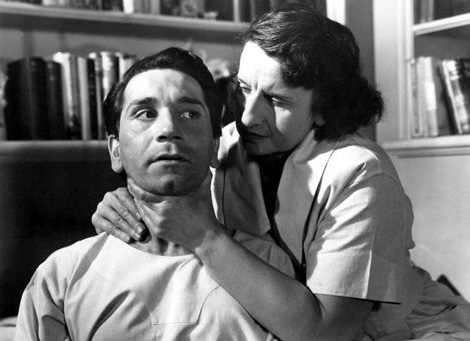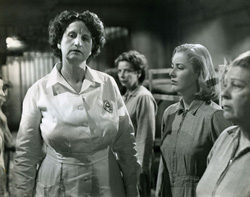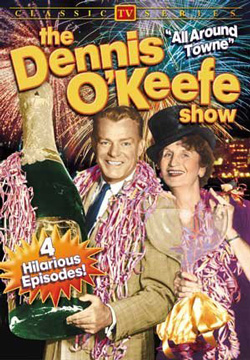
The main exception to this rule was the gloriously evil Hope Emerson. At 6-foot-2 and 230 pounds, Emerson not only eclipsed her female costars she also towered over most of her leading men. With her large forehead, thick jowls, and long beaked nose, Emerson looked like the female version of the big lug henchman, and when she got to Hollywood the town wasted no time in casting her as a villain.
Her first role in a major production was as the hulking masseuse Rose Given in Robert Siodmak’s Cry of the City. Her first appearance in the film is memorable: walking through a house in the middle of the night, switching on lights in each successive room, she grows ever larger as she approaches the camera. She looms over her 5-foot-8-inch costar, Richard Conte. He plays an escaped convict named Martin Rome, a smooth-talking ladies’ man who has easily manipulated every other woman in the film. Because she has criminal connections, he’s come to Rose Given for help, and he begins flirting with her almost immediately. When she offers him a back rub, he thinks his flirtations have worked again.
But Rose is different from the other women in the film. As her hands move up his back, he rolls his eyes in pleasure, but then she clamps down on his throat and his neck disappears between her huge mitts. Unlike most noir, the woman’s threat to the man here has nothing to do with sex or seduction, it’s purely violent. Emerson looks as if she could pop off his head like a champagne cork. The scene is the rare example in a movie of a woman terrorizing a man with her bare hands.

It won’t be easy. The prison is managed on the cell block level by a hulking sadist named Evelyn Harper (Emerson). Miss Harper runs roughshod over the girls, demanding money for protection and dishing out brutal punishments for small infractions. It’s a trope of this subgenre that the real danger always comes from the guards, not the other inmates. For camp purposes, this teases the audience with expressions of the dominant/submissive relationship, but if this is the stuff of S&M fantasy, it can also be the stuff of great drama. Like Jules Dassin’s men-in-prison picture Brute Force, Caged is a film that finds serious faults with the penal system. Written by Phantom Lady screenwriter Bernard Schoenfeld, the script was based on research ex-journalist Virginia Kellogg gained by incarcerating herself in women’s prisons. The plot is standard good-girl-goes-to-jail stuff, but the details of enforced monotony and self-defeating bureaucracy have the smack of authenticity.
The film is an underrated masterpiece, gorgeously shot and wonderfully acted. In a cast that is universally excellent, Emerson stands out, creating one of the all-time great villains in Miss Harper. Most commentators read her character as an angrily repressed lesbian, and indeed the scene where she visits the girls dressed up for the evening and tells them about her boyfriend seems to be more about taunting them with what she knows they want than the truth of any real engagement. We never see the boyfriend, and I suspect that Miss Harper walked outside and caught the bus home for the evening. In her book Female Masculinity, cultural critic Judith Halberstam notes that Harper “indulges herself in ‘feminine comforts’ . . . not, one feels, for the pleasure she gains from femininity but because femininity is what is denied to the inmates.” (For more on lesbian representation in film noir, read my essay “All Kinds Of Women.”)

In a way, it made sense that Emerson should end up in comedy. Born in Iowa in 1897, she was actually comic by nature and training. After starting out in vaudeville in a comedy team with her mother, Josie, she later toured stages around the country with the comedian Billy House. In the thirties, she made it to the stages and radios of New York City and played in productions like Lysistrata and the hillbilly musical Swing Your Lady. To help pay the bills, she worked the New York nightclub circuit, singing risqué tunes for largely gay crowds at clubs like Fifth Avenue One in Greenwich Village. Then in the late forties, she went out to Hollywood and became a baddie. When she transitioned into comedy, it was as if she’d come full circle.
When Emerson died of liver failure in 1960, she was mostly remembered for her comic roles on television and in the movies, but her work in film noir is probably the stuff she’ll be remembered for in the long run. When she was scary, you couldn’t take your eyes off of her.
Read Jake Hinkson’s other posts about Noir’s Goon Squad.
Jake Hinkson, The Night Editor, is the author of Hell on Church Street.

Jake, can you please program an evening–or a week, or a month–on TCM and let me know when it’s on so I can watch all of the great movies and actors you write about?
Comedians often make great villains. They give the character an essential crazy edge.
So far I have read the first two chapters and it was very good. The author has a unique way of getting to the point, while also adding details. I am looking forward to reading more of this book.